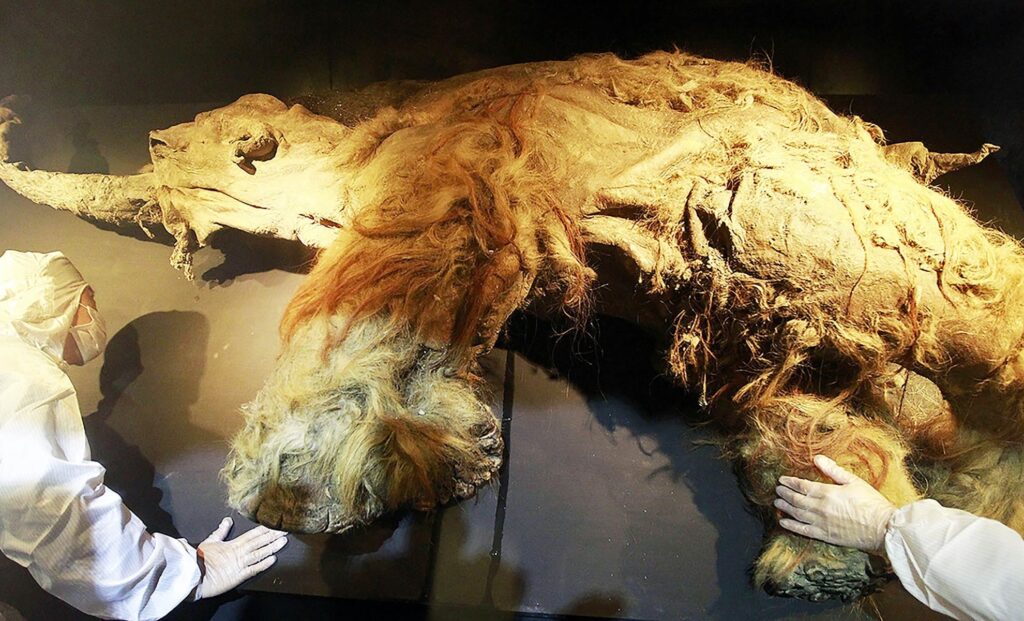Unlike DNA, which offers genetic potential, RNA captures a snapshot of gene activity in real time. This new approach offers scientists an unexpectedly intimate look at the final biological moments of an Ice Age giant.
For decades, the story of the woolly mammoth—its biology, habits, and extinction—was largely pieced together from bones, teeth, and fragments of DNA. But RNA, a far more fragile molecule, was thought too unstable to survive millennia. The discovery by researchers at Stockholm University, led by Emilio Mármol and Love Dalén, shatters that assumption. They managed to isolate and analyze RNA strands from muscle tissue, offering an insight into the living physiology of a long-extinct creature.
The remains belong to Yuka, a juvenile mammoth whose mummified body was recovered in exceptional condition in the Siberian permafrost. This natural deep freeze preserved the mammoth’s soft tissues well enough to yield ancient RNA—something previously thought impossible beyond a few centuries.
Revealing Which Genes Were Still Active
The significance of RNA lies in its ability to show gene expression—that is, which genes were “turned on” at the time of death. According to researcher Emilio Mármol, this enables scientists to “obtain direct evidence of which genes are ‘turned on,’ offering a glimpse into the final moments of life of a mammoth that walked the Earth during the last Ice Age.”
The researchers found that only a subset of the mammoth’s roughly 20,000 protein-coding genes were active in Yuka’s muscle tissue. Some of these genes were involved in muscle contraction and cellular stress response. This fits with previous research suggesting that Yuka may have been attacked by predators shortly before dying. Mármol noted, “We found signs of cell stress,” which adds a poignant dimension to the scientific discovery.
Love Dalén, a professor of evolutionary genomics and co-lead on the study, explained that this RNA survival expands the known limits of ancient biomolecular preservation. “We have previously pushed the limits of DNA recovery past a million years. Now, we wanted to explore whether we could expand RNA sequencing further back in time than done in previous studies.”

Revealing Which Genes Were Still Active
Another unexpected finding was the presence of non-coding RNAs, particularly microRNAs, which help regulate gene expression without producing proteins. These molecules play key roles in cellular functions and development. Study co-author Marc Friedländer called the discovery “one of the most exciting findings,” emphasizing that this is the first time microRNAs have been recovered from remains this old.
Bastian Fromm, from the Arctic University Museum of Norway, pointed out that some of these microRNAs showed rare mutations, providing strong evidence that they were genuinely of mammoth origin. “We even detected novel genes solely based on RNA evidence, something never before attempted in such ancient remains,” Fromm explained.
According to Earth.com, this type of molecular data allows researchers to confirm the authenticity of the samples and to distinguish them from modern contaminants—an ever-present concern in ancient biomolecule studies.


A New Frontier in Paleogenetics
Beyond the woolly mammoth, the implications of this work stretch further. RNA, especially from viruses or soft tissues, could open a new line of inquiry into other extinct creatures, or even Ice Age pathogens. “Our results demonstrate that RNA molecules can survive much longer than previously thought,” said Dalén. This could allow scientists to sequence ancient RNA viruses such as coronaviruses or influenza strains trapped in frozen remains.
Researchers hope to integrate RNA findings with existing data from DNA and proteins to build a fuller picture of extinct species’ biology. Mármol explained that such an approach could “fundamentally reshape our understanding of extinct megafauna” by offering access to cellular processes frozen in time.

